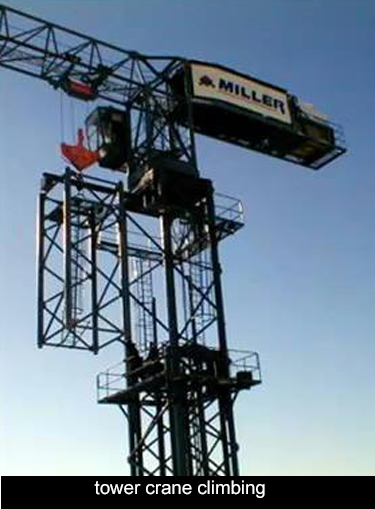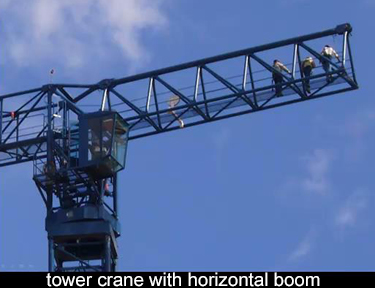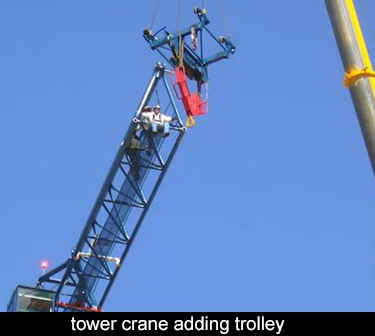We're now going to switch topics and talk about tower cranes in heavy construction. We typically use conventional cranes, such as the crawler crane in the middle of this photo, but from time to time we do use tower cranes. However, I thought that it would be a good idea to at least cover the subject of tower cranes, whether they're applied at buildings -which is their typical use- or in heavy construction. It's something that you really should know about. People are always asking me how these cranes climb. In general, it's good information to have.
 Why am I starting with this crane? Well, I've already explained to you, I can't go buy a red crane without taking a picture of it. Here's one more picture for my library. On the right hand side, these black sections are sections of a tower which will eventually house a tower crane. To answer the question of how does the crane gets started? How does the tower crane get started? It's erected by a conventional crane, such as this crawler crane. The crawler crane will assemble those sections of tower. When they reach a predetermined height, you will actually lift up the tower crane and sit it up there on top of the tower.
Why am I starting with this crane? Well, I've already explained to you, I can't go buy a red crane without taking a picture of it. Here's one more picture for my library. On the right hand side, these black sections are sections of a tower which will eventually house a tower crane. To answer the question of how does the crane gets started? How does the tower crane get started? It's erected by a conventional crane, such as this crawler crane. The crawler crane will assemble those sections of tower. When they reach a predetermined height, you will actually lift up the tower crane and sit it up there on top of the tower.

Here's a good view of the tower cranes at the very beginning of their function. The crawler crane has already constructed the tower and then it lifts the crane and sits it on top of the tower. Of course, it's not all in one piece, that would be a very, very heavy lift. It lifts it in sections. The tower crane is actually joined together and assembled in the air.
 There are two types of tower cranes - at least two types. The type shown here has a luffing boom. That's a boom that can boom up and boom down. It looks very much, in fact, this unit looks very much like the crawler crane that's down on the ground. These cranes have very high capacity. There are other cranes where the boom is in a fixed horizontal position and there's a little trolley that rides on it and carries the load back and forth. Those are generally lighter capacity. For this building, it was determined that this heavy capacity crane would be needed. In fact, I think as many as four tower cranes were eventually used on this project.
There are two types of tower cranes - at least two types. The type shown here has a luffing boom. That's a boom that can boom up and boom down. It looks very much, in fact, this unit looks very much like the crawler crane that's down on the ground. These cranes have very high capacity. There are other cranes where the boom is in a fixed horizontal position and there's a little trolley that rides on it and carries the load back and forth. Those are generally lighter capacity. For this building, it was determined that this heavy capacity crane would be needed. In fact, I think as many as four tower cranes were eventually used on this project.
After the crawler crane has assembled the tower crane, the tower crane turns around and disassembles the crawler crane. I'm not sure why this reminds me of a praying mantis. The female eventually turns around and bites the head off the male. Here we have a crawler crane with its head missing. It is, in fact, being stripped down to the simplest parts, so that it can be lifted out of the hole.
 This is a good picture of a tower crane. This is of the type with a fixed horizontal boom. The loads move back and forth by means of this trolley, which rides along the boom. This crane is now in the process of growing, or jumping or climbing whichever term you like. The process is very straightforward. The upper section is larger than the tower below, and it telescopes over the tower, and you can see that here very clearly. The upper section here has been lifted with hydraulic jacks to this position, and an additional section of tower has been lifted. It’s going to slide horizontally in place.
This is a good picture of a tower crane. This is of the type with a fixed horizontal boom. The loads move back and forth by means of this trolley, which rides along the boom. This crane is now in the process of growing, or jumping or climbing whichever term you like. The process is very straightforward. The upper section is larger than the tower below, and it telescopes over the tower, and you can see that here very clearly. The upper section here has been lifted with hydraulic jacks to this position, and an additional section of tower has been lifted. It’s going to slide horizontally in place.
continue >